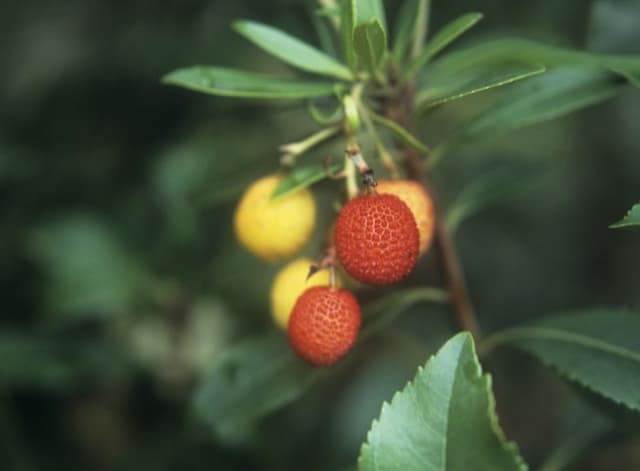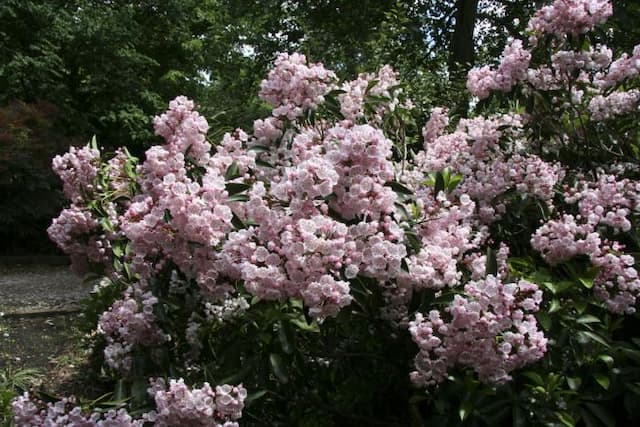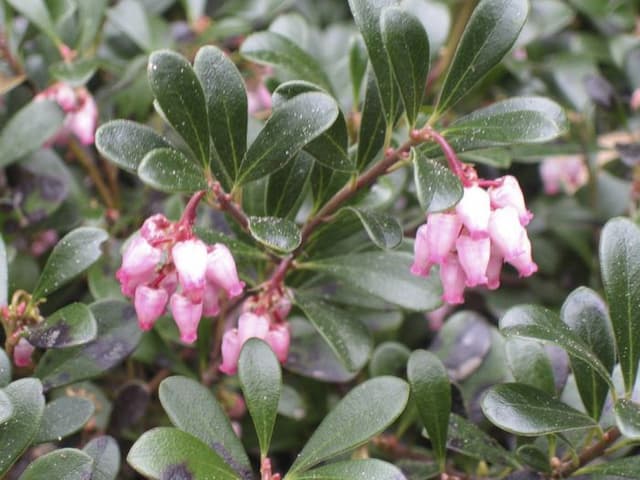Sourwood Oxydendrum arboreum

ABOUT
The plant commonly known as sourwood is adorned with glossy green leaves that display an elongated oval shape with finely toothed margins. These leaves are noteworthy for their brilliant transformation during the fall when they take on stunning shades of brilliant reds, purples, and sometimes yellows, creating a spectacular autumnal display. The sourwood blooms in early to mid-summer, producing quite the visual spectacle. It graces its branches with elongated clusters of lily-of-the-valley-like flowers that hang delicately. These flowers are a crisp white and bring a light, airy feel to the plant as they dangle and sway with the breeze. The blossoms are not only beautiful to look at, but also attract a host of pollinators, particularly bees which forage for the nectar to produce a distinctive honey. The bark of sourwood provides textural interest, being gray to brown, with a ridged and furrowed appearance, adding to the plant's ornamental value even in the colder months when the branches are bare. The visual charm of the sourwood is multifaceted, changing with the seasons and offering year-round interest in various landscape settings.
About this plant
 Names
NamesFamily
Ericaceae
Synonyms
Sourwood, Sorrel Tree, Lily-Of-The-Valley Tree, Appalachian Lily Tree, Titi
Common names
Andromeda arborea, Oxydendron arboreum.
 Toxicity
ToxicityTo humans
The plant known as Sourwood is generally not considered toxic to humans. There are no well-documented cases of poisoning from ingesting parts of this plant. However, as with any plant, individuals may have varying sensitivities, and it is generally not advisable to consume parts of ornamental or wild plants due to the potential for adverse reactions.
To pets
Sourwood is not commonly listed as a toxic plant to pets, such as dogs and cats. There is limited information on its toxicity, but it is not typically recognized as a plant that causes poisoning in pets. As with any non-food plant, ingestion of plant material could potentially cause mild stomach upset in some animals. If an animal ingests Sourwood and shows signs of distress, it is best to consult a veterinarian.
 Characteristics
CharacteristicsLife cycle
Perennials
Foliage type
Deciduous
Color of leaves
Green
Flower color
White
Height
25 feet (7.62 meters)
Spread
20 feet (6.10 meters)
Plant type
Tree
Hardiness zones
5
Native area
North America
Benefits
 General Benefits
General Benefits- Aesthetic Appeal: Oxydendrum arboreum, commonly known as sourwood, adds ornamental value to landscapes with its white bell-shaped flowers, glossy green leaves, and brilliant red fall foliage.
- Wildlife Habitat: Sourwood trees provide shelter and nesting sites for various birds and small mammals.
- Nectar Source: The tree's flowers are a rich source of nectar for bees and other pollinating insects, which is crucial for maintaining healthy ecosystems.
- Soil Improvement: Sourwood can improve soil conditions by adding organic matter through leaf litter and providing shade that helps retain soil moisture.
- Shade Provision: Mature sourwood trees can offer cooling shade, which can reduce the need for artificial cooling in nearby buildings and create comfortable outdoor spaces.
- Erosion Control: The root system of sourwood trees helps to stabilize soil and prevent erosion on slopes and in areas prone to soil degradation.
- Cultural Significance: Sourwood holds cultural importance in certain regions, particularly in the southern United States, where it is celebrated for its beauty and the honey produced from its nectar.
 Medical Properties
Medical PropertiesThis plant is not used for medical purposes.
 Air-purifying Qualities
Air-purifying QualitiesThis plant is not specifically known for air purifying qualities.
 Other Uses
Other Uses- Oxydendrum arboreum, also known as Sourwood, can be used as a natural source of nectar for bees to create sourwood honey, which is highly valued for its unique taste.
- The wood of Sourwood is occasionally used for small woodworking projects, such as tool handles, due to its fine grain and strength.
- Sourwood leaves can be used in the garden as a natural mulch; they decompose slowly providing longer-lasting soil protection and nutrients.
- The tree's consistent fall coloration makes it excellent for ornamental purposes in landscape designing.
- Its hard, dense wood is sometimes utilized for specialty carvings and turnery.
- Sourwood can be planted on slopes and banks for erosion control as its root system helps stabilize the soil.
- The flowers of Sourwood can be infused into water or oils to create natural fragrances or for use in homemade potpourri.
- The tree can be used in educational settings to study the impact of acidic soils on plant growth, as it naturally thrives in such environments.
- Leaves of the Sourwood tree can be used as a natural dye source for fabrics, yielding colors ranging from green to yellow shades.
- In areas where the Sourwood is native, the tree serves as a source of cultural heritage and is included in local folklore and tradition.
Interesting Facts
 Feng Shui
Feng ShuiThe Sourwood is not used in Feng Shui practice.
 Zodiac Sign Compitability
Zodiac Sign CompitabilityThe Sourwood is not used in astrology practice.
 Plant Symbolism
Plant Symbolism- Timelessness: Also known as the Sourwood tree, Oxydendrum arboreum often symbolizes timelessness because it can live for many years and showcases its beauty through changing seasons.
- Independence: This tree can grow well even in acidic and poor soils, which stands for resilience and the ability to thrive in challenging conditions, much like an independent individual.
- Adaptability: Sourwood trees are adaptable to various environments, symbolizing the capacity to adjust and prosper in different life circumstances.
- Balance: With its symmetrical shape and the contrast between its bright green leaves and white summertime flowers, the Sourwood tree represents balance and harmony in nature.
 Water
WaterThe Sourwood tree (Oxydendrum arboreum) prefers consistent moisture but requires well-drained soil. During its growing season in spring and summer, water the tree once a week with about 1 to 1.5 gallons of water, unless there is sufficient rainfall. Decrease the frequency to every two to three weeks during the fall before the tree becomes dormant in winter. If the weather is particularly dry, you might need to water the tree during the winter months. Always check the soil moisture at about 2 inches depth; if the soil feels dry, it's time to water.
 Light
LightThe Sourwood tree thrives in full sun to partial shade conditions. Ideally, it should receive at least four to six hours of direct sunlight per day. The best spot for planting a Sourwood tree is in a location where it will receive morning sunlight and some afternoon shade, especially in hotter climates, to prevent stress from excessive heat.
 Temperature
TemperatureThe Sourwood tree is able to withstand a range of temperatures and climates but prefers moderate conditions. It can survive in temperatures as low as -20°F and as high as 90°F. The ideal growing temperatures for this tree range from 60°F to 80°F. Oxydendrum arboreum is a hardy tree once established but should be protected from extreme cold when young.
 Pruning
PruningThe Sourwood tree requires minimal pruning, mostly to maintain its shape and remove any damaged or diseased branches. Prune the tree during its dormancy in late winter or early spring before the new growth starts. Remove any crossing or rubbing branches to promote healthy growth and good air circulation. Occasional thinning may be necessary to maintain the tree's structural integrity.
 Cleaning
CleaningAs needed
 Soil
SoilThe Sourwood tree prefers acidic soil with a pH between 5.0 and 6.5. A good soil mix should be well-draining and rich in organic matter. Incorporate peat moss, compost, and a pine bark mix to create an ideal substrate for this tree's roots.
 Repotting
RepottingSourwood trees are typically not repotted as they are trees meant to be planted outdoors. Once established, they do not require repotting; if transplanted, it should be done during dormancy in late fall or winter.
 Humidity & Misting
Humidity & MistingSourwood trees thrive in an environment with moderate humidity. They are adaptable to outdoor conditions in their native range and do not require specific humidity levels when planted in the landscape.
 Suitable locations
Suitable locationsIndoor
Sourwood is not suitable for indoor growing due to its size.
Outdoor
Plant in acidic soil, full sun to partial shade, and water regularly.
Hardiness zone
5-9 USDA
 Life cycle
Life cycleOxydendrum arboreum, commonly known as the sourwood or sorrel tree, begins its life cycle with seed germination, which is facilitated by a combination of warm temperatures and moist soil conditions. Upon germination, the seedling emerges and begins to grow roots and shoots, developing into a young sapling. As the sapling matures, it undergoes a period of vegetative growth where it establishes a robust root system and a sturdy trunk, simultaneously growing in height and girth. During this stage, the sourwood develops its characteristic elongated leaves that turn brilliant shades of red and purple in the fall. Upon reaching maturity, which can take several years, the sourwood produces clusters of fragrant, white flowers during the summer, which are highly attractive to pollinators like bees, and eventually give way to seed capsules. The tree continues to cycle through seasonal growth and reproduction, with mature trees living up to 100-200 years, creating new generations through seed dispersal, as well as contributing to the ecosystem as a valuable source of nectar and through its falling leaves that enrich the forest floor.
 Propogation
PropogationPropogation time
Spring-Early Summer
Propogation: The most popular method of propagating the Sourwood (Oxydendrum arboreum) is through seed. Seeds should ideally be sown in fall directly after collection to take advantage of the cold winter months that help break the seeds’ dormancy through a process called stratification. However, if immediate sowing isn’t possible, seeds can be stored in a cool, dry place and then stratified artificially by mixing them with moist sand and placing them in a refrigerator, usually set at about 40 degrees Fahrenheit (4 degrees Celsius), for about 60 to 90 days before sowing in the spring. The stratified seeds are then sown in well-drained soil in a sunny location, lightly covered with soil, and kept consistently moist until germination, which can take several weeks. Because Sourwood is known for its slow growth and difficulty in transplantation, seeds are often preferred to establish new plants in the location where they are intended to grow to maturity.









